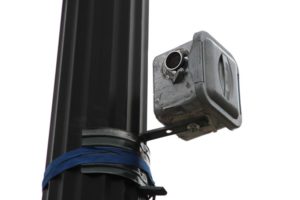 (Updated at 12:00 p.m.) Red light running decreased in Arlington at intersections with cameras, according to a new study from the Insurance Institute for Highway Safety (IIHS).
(Updated at 12:00 p.m.) Red light running decreased in Arlington at intersections with cameras, according to a new study from the Insurance Institute for Highway Safety (IIHS).
The study focused on the cameras installed in 2010 at four heavily traveled Arlington intersections — southbound Fort Myer Drive at westbound Lee Highway, northbound N. Lynn Street at eastbound Lee Highway, northbound N. Glebe Road at Fairfax Drive and westbound Washington Blvd at Lee Highway. The public was informed of the camera installation and violators were given warnings for 30 days. After the grace period, violators caught on camera received a $50 citation.
Researchers at the IIHS (which is located in Arlington) taped traffic during the warning period, one month after ticketing began and again one year later. They found that one year after ticketing began there was a marked decrease in drivers running red lights. Violations occurring at least 0.5 seconds after the light turned red were 39 percent less likely, those occurring at least 1 second after were 48 percent less likely and there was an 86 percent drop in violations occurring at least 1.5 seconds after the light changed.
“This study provides fresh evidence that automated enforcement can get drivers to modify their behavior,” says Anne McCartt, senior vice president for research at IIHS and the study’s lead author. “What these numbers show is that those violations most likely to lead to a crash are reduced the most. The longer the light has been red when a violator enters an intersection, the more likely the driver is to encounter a vehicle traveling in another direction or a pedestrian.”
Traffic was also taped at four other intersections — westbound Lee Highway at Kirkwood Road, northbound N. Glebe Road at Washington Blvd, westbound Arlington Blvd at Manchester Street and eastbound Columbia Pike at S. George Mason Drive — to see if there was any spillover effect from the cameras. While there were some decreases in violations observed in areas close to cameras, they were not always deemed statistically significant.
In 2011, the first full year the four red light cameras were in operation, they brought in nearly $460,000 in revenue. That number halved in 2012, coming in at about $224,000. The camera at Southbound Fort Myer Drive and Lee Highway brought in the most revenue, with a two year total of nearly $304,000.
In April, the county plans to activate seven additional traffic cameras at five intersections shown to have high rates of violations. There will be two at Columbia Pike and Glebe Road monitoring Eastbound and Westbound Columbia Pike, two at S. 23rd Street and Jefferson Davis Highway monitoring Northbound and Southbound Jefferson Davis Highway, one at Columbia Pike and George Mason Drive monitoring Eastbound Columbia Pike, one at Lee Highway and George Mason Drive monitoring Westbound Lee Highway and one at Washington Blvd and Glebe Road monitoring Northbound Glebe Road. The standard one month warning period will apply, and violators will be ticketed after that time.







